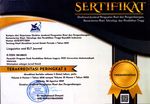Analyzing Errors in Students’ Writing
Abstract
Keywords
Full Text:
PDFReferences
Ilham, “Needs Analysis of Project-Based Learning Model in Writing Paragraphs from EFL Students ’ Perspectives,” vol. 12, no. 1, pp. 282–295, 2024.
N. P. I. M. C. Manik and N. K. Arie Suwastini, “Analyzing Grammatical Error in Students’ Recount Text Writing in Junior High School,” Humanis, vol. 24, no. 3, p. 238, 2020, doi: 10.24843/jh.2020.v24.i03.p02.
E. T. Handayani and D. Aminatun, “Students’ Point of View on the Use of Whatsapp Group To Elevate Writing Ability,” J. English Lang. Teach. Learn., vol. 1, no. 2, pp. 31–37, 2020, doi: 10.33365/jeltl.v1i2.602.
R. N. Moses and M. Mohamad, “Challenges Faced by Students and Teachers on Writing Skills in ESL Contexts: A Literature Review,” Creat. Educ., vol. 10, no. 13, pp. 3385–3391, 2019, doi: 10.4236/ce.2019.1013260.
A.D. Jayanti, “Students’ Writing Ability on English Descriptive Text at Grade VIII in SMPN 33 Padang ENGLISH FRANCA : Academic Journal of English Language and Education Vol. 3, No. 1. https://journal.iaincurup.ac.id/index.php/english/article/view/843/pdf,” Students’ Writ. Abil. English Descr. Text Grade VIII SMPN 33 Padang ENGLISH Fr. Acad. J. English Lang. Educ., vol. 3, no. 1, pp. 7823–7830, 2019.
B. Musthafa and F. N. Yusuf, “University Student S ’ Needs Of Writing Course Materials : A Case of Indonesia,” Vol. 8, No. 2, pp. 195–202, 2020, doi: 10.25134/erjee.v8i2.2988.Received.
A. Husna and A. Multazim, “Students’ Difficulties in Writing Recount Text At Inclusion Classes,” LET Linguist. Lit. English Teach. J., vol. 9, no. 1, p. 52, 2019, doi: 10.18592/let.v9i1.3077.
V. Hafiz, M., Fitri, “Student of English Language Teaching Program of FBS UNP graduated on March 2013 Advisor, lecturer of FBS Universitas Negeri Padang,” J. English Lang. Teach., vol. 1, no. 2, pp. 292–300, 2013.
H. Herman, T. A. Rajagukguk, and P. S. R. Sihombing, “the Effect of Using Collaborative Writing Method on Students’ Writing Recount Text At Grade Ten of Smk Yp 1 Hkbp Pematangsiantar,” ACITYA J. Teach. Educ., vol. 2, no. 2, pp. 95–114, 2020, doi: 10.30650/ajte.v2i2.1363.
Ilham, “Implementing Project-Based Learning for EFL Students ’ Writing Achievement at the Tertiary Level,” Vol. 10, No. 3, pp. 1003–1012, 2022.
I. Gulö and T. V. Rahmawelly, “An Analysis of Omission in Students’ English Writings,” Teknosastik, vol. 16, no. 2, p. 55, 2019, doi: 10.33365/ts.v16i2.141.
J. Hasan and M. Marzuki, “An Analysis of Student’s Ability in Writing at Riau University Pekanbaru - Indonesia,” Theory Pract. Lang. Stud., vol. 7, no. 5, p. 380, 2017, doi: 10.17507/tpls.0705.08.
A. Ariyanti and R. Fitriana, “E FL Students’ Difficulties and Needs in Essay Writing A. Ariyanti 1 , Rinda Fitriana 1 1,” Adv. Soc. Sci. Educ. Humanit. Res., vol. 158, no. Ictte, pp. 111–121, 2017.
M. Alhaysony, “An analysis of article errors among Saudi female EFL students: A case study,” Asian Soc. Sci., vol. 8, no. 12, pp. 55–66, 2012, doi: 10.5539/ass.v8n12p55.
heldi Dulay, marina Burt, and stephen Krashen, “Majer H. Dulay, M. Burt, S. Krashen Language Two. Oxford 1982.pdf.” p. 315, 1982.
H. Hikmah, “Analysis of Omission and Addition Errors Found in the Students’ English Texts,” ELTICS J. English Lang. Teach. English Linguist., vol. 5, no. 1, 2020, doi: 10.31316/eltics.v5i1.526.
S. Islam and P. N. Mufidah, “An Analysis of Grammatical Error on Students’ Writing,” Int. J. English Educ. Linguist., vol. 4, no. 1, pp. 1–13, 2022, doi: 10.33650/ijoeel.v4i1.3826.
E. Erickson, “An Analysis of Writers’ Errors in Producing Descriptive Texts; Intercultural Studies,” J. Lang. Lang. Teach., vol. 10, no. 3, p. 444, 2022, doi: 10.33394/jollt.v10i3.5389.
DOI: https://doi.org/10.31764/leltj.v11i2.20193
Refbacks
- There are currently no refbacks.
Copyright (c) 2023 Erni Sona Aristia

This work is licensed under a Creative Commons Attribution-ShareAlike 4.0 International License.
_____________________________________________________
Linguistics and ELT Journal
p-ISSN 2339-2940 | e-ISSN 2614-8633

LELTJ is licensed under a Creative Commons Attribution-ShareAlike 4.0 International License.
_____________________________________________________
LELTJ is abstracting & indexing in the following databases:
_____________________________________________________
LELTJ Editorial Office:













